Abstract
Activated B and T lymphocytes from normal human subjects are known to have the specific high-affinity receptor for 1,25-dihydroxyvitamin D3 (1,25-(OH)2-D3). In an attempt to determine a functional role for the sterol in such cells, we studied the effect of 1,25-(OH)2-D3 on DNA synthesis and Ig production by normal human peripheral blood mononuclear (PBM) cells activated in vitro by the polyclonal lymphocyte activators pokeweed mitogen and phytohemagglutinin, and the specific antigen dermatophyton O. A dose-dependent inhibition of [3H]thymidine incorporation was observed in cells incubated with 1,25-(OH)2-D3 in concentrations ranging from 10(-10) to 10(-7) M. Production of IgG and IgM, determined by enzyme-linked immunosorbent assay, was similarly inhibited by increasing concentrations of 1,25-(OH)2-D3. Half-maximal inhibition of DNA and Ig synthesis was found at 10(-10) to 10(-9) M 1,25-(OH)2-D3. This suppressive effect was specific for 1,25-(OH)2-D3; of the other vitamin D metabolites examined, only 10(-7) M 24R,25 dihydroxyvitamin D3 (24,25-(OH)2-D3) had a similar inhibitory effect. 1,25-(OH)2-D3 was not cytotoxic and did not affect unactivated PBMs. These data demonstrate that 1,25-(OH)2-D3 is a potent inhibitor of human PBM Ig production in vitro and suggest that this action is mediated through the hormone's antiproliferative effect on Ig-producing B cells and/or helper T cells.
Full text
PDF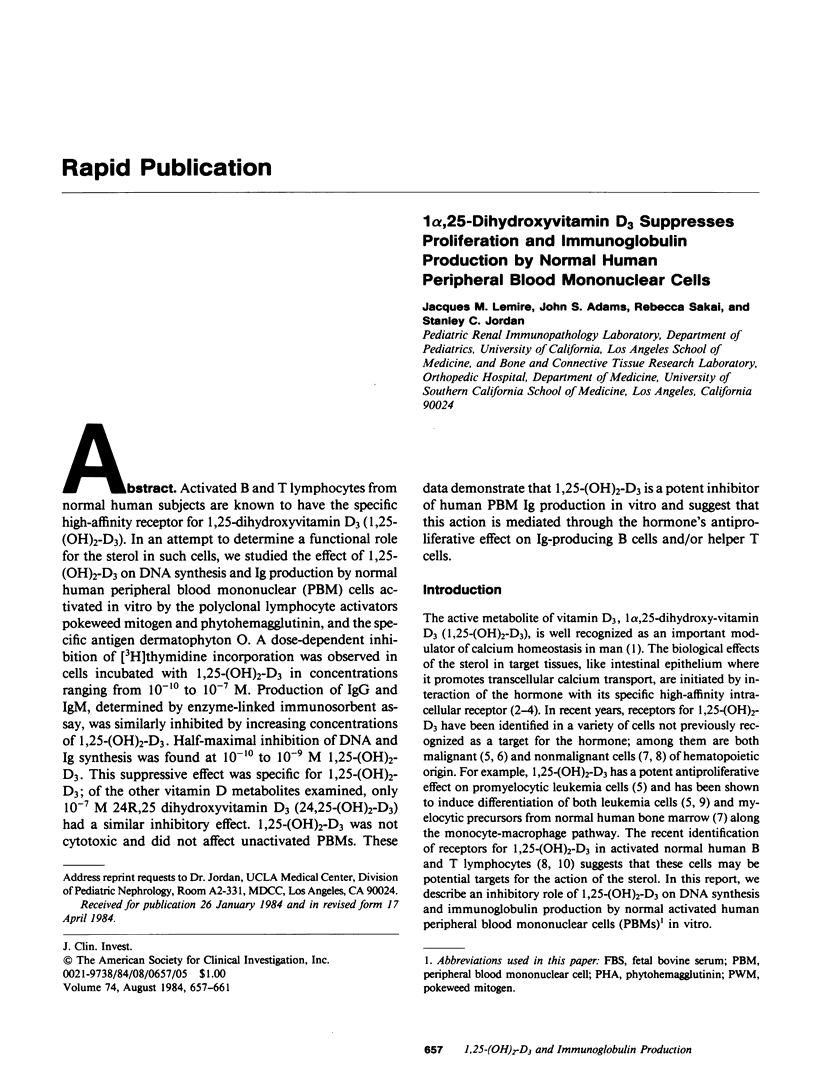
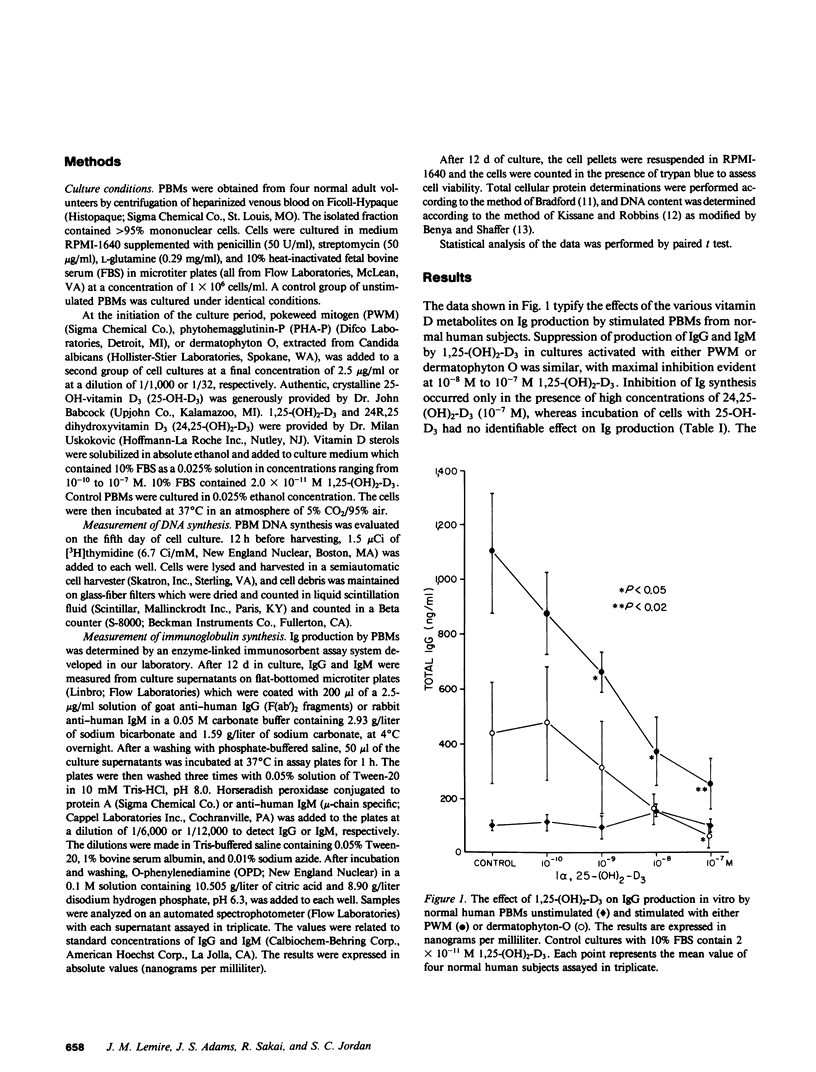
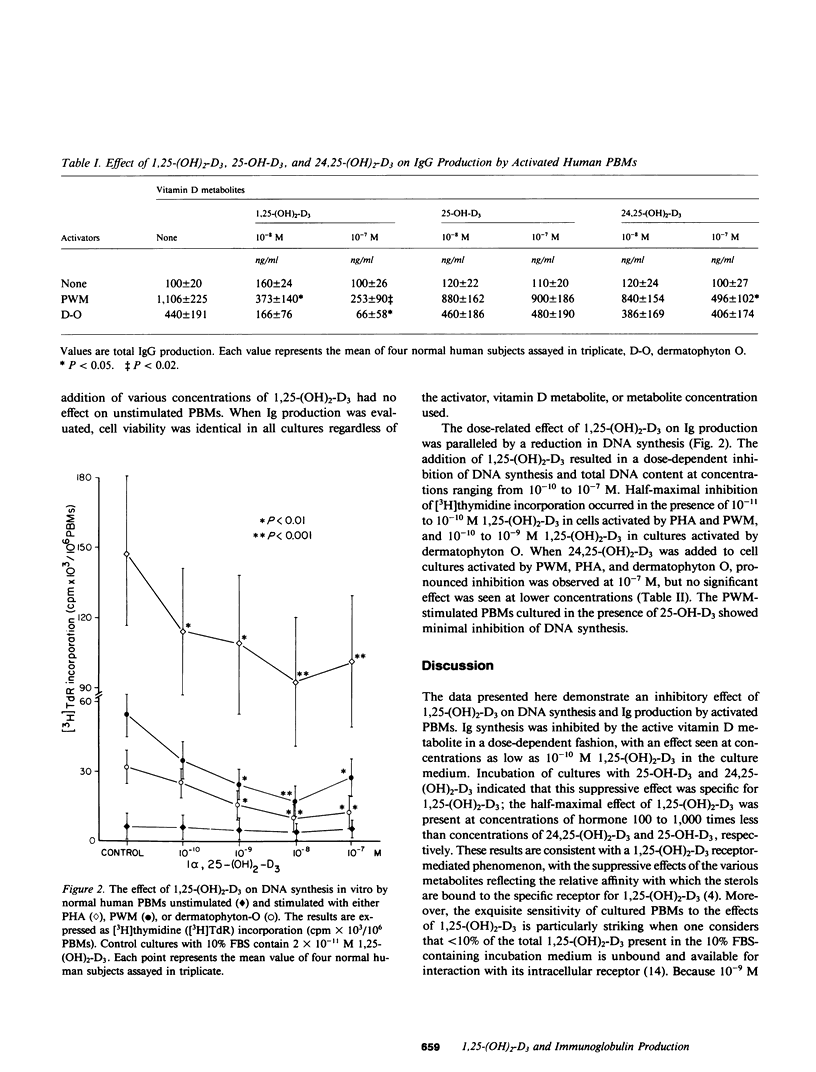
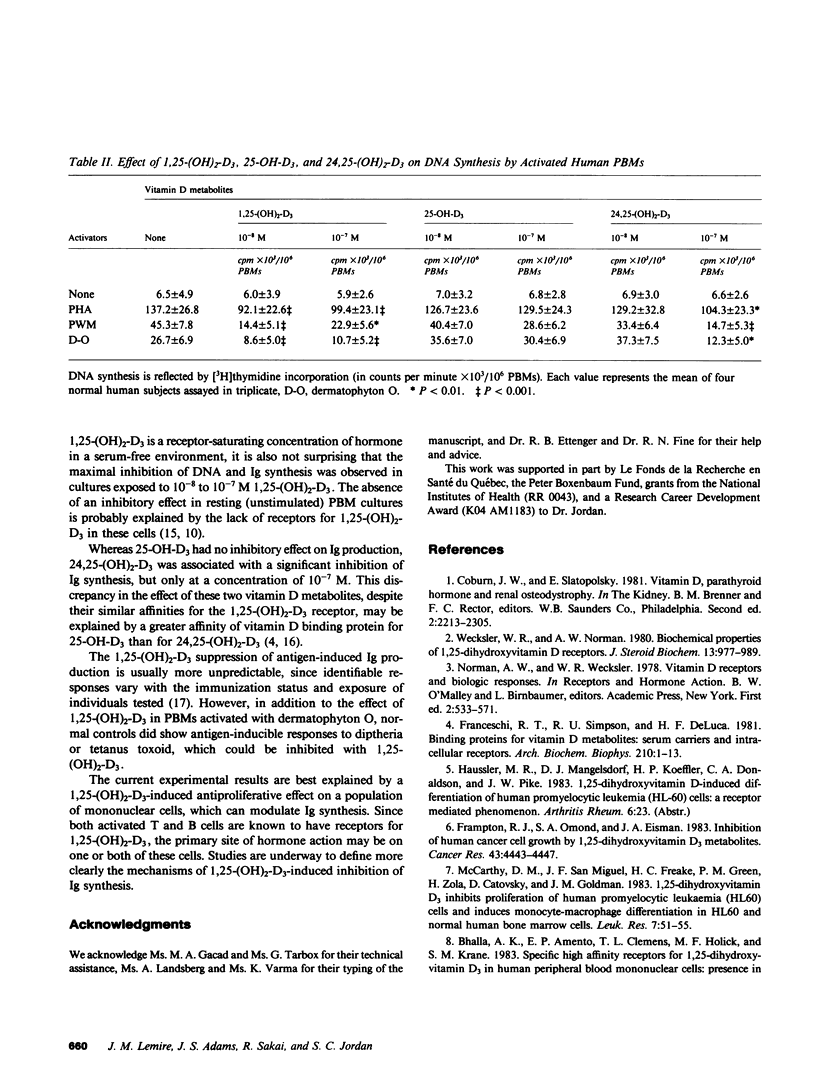
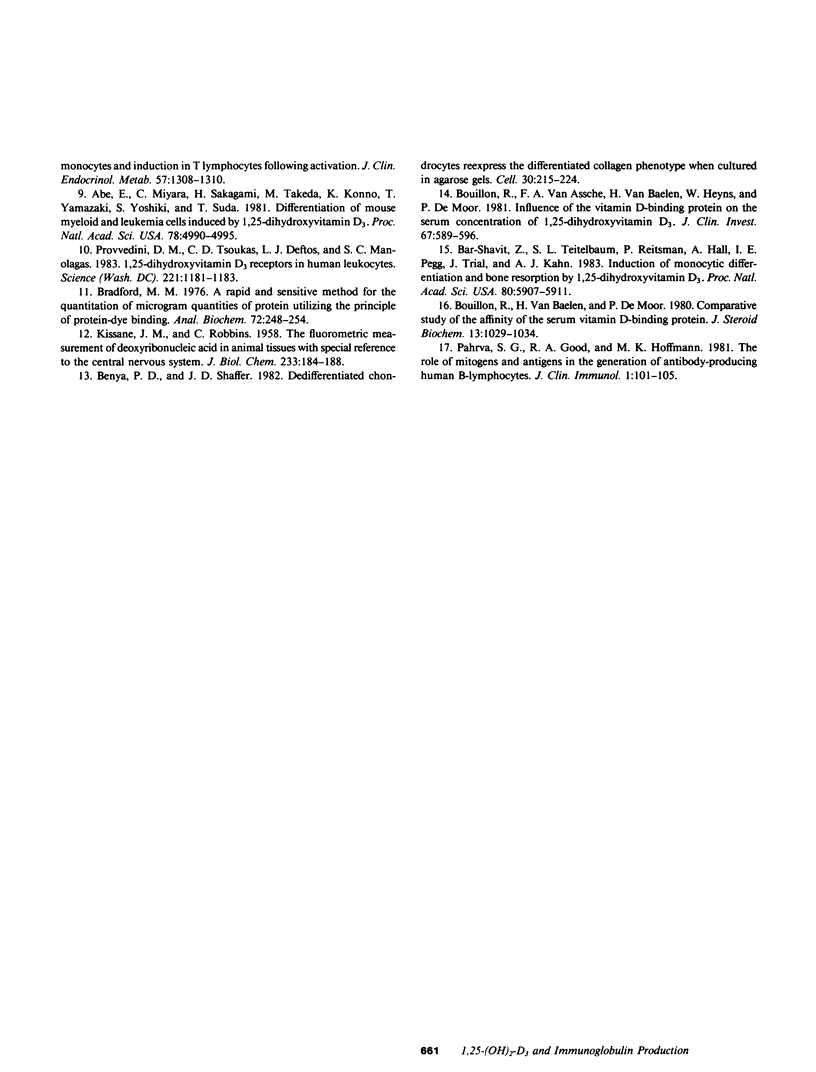
Selected References
These references are in PubMed. This may not be the complete list of references from this article.
- Abe E., Miyaura C., Sakagami H., Takeda M., Konno K., Yamazaki T., Yoshiki S., Suda T. Differentiation of mouse myeloid leukemia cells induced by 1 alpha,25-dihydroxyvitamin D3. Proc Natl Acad Sci U S A. 1981 Aug;78(8):4990–4994. doi: 10.1073/pnas.78.8.4990. [DOI] [PMC free article] [PubMed] [Google Scholar]
- Bar-Shavit Z., Teitelbaum S. L., Reitsma P., Hall A., Pegg L. E., Trial J., Kahn A. J. Induction of monocytic differentiation and bone resorption by 1,25-dihydroxyvitamin D3. Proc Natl Acad Sci U S A. 1983 Oct;80(19):5907–5911. doi: 10.1073/pnas.80.19.5907. [DOI] [PMC free article] [PubMed] [Google Scholar]
- Benya P. D., Shaffer J. D. Dedifferentiated chondrocytes reexpress the differentiated collagen phenotype when cultured in agarose gels. Cell. 1982 Aug;30(1):215–224. doi: 10.1016/0092-8674(82)90027-7. [DOI] [PubMed] [Google Scholar]
- Bhalla A. K., Amento E. P., Clemens T. L., Holick M. F., Krane S. M. Specific high-affinity receptors for 1,25-dihydroxyvitamin D3 in human peripheral blood mononuclear cells: presence in monocytes and induction in T lymphocytes following activation. J Clin Endocrinol Metab. 1983 Dec;57(6):1308–1310. doi: 10.1210/jcem-57-6-1308. [DOI] [PubMed] [Google Scholar]
- Bouillon R., Van Assche F. A., Van Baelen H., Heyns W., De Moor P. Influence of the vitamin D-binding protein on the serum concentration of 1,25-dihydroxyvitamin D3. Significance of the free 1,25-dihydroxyvitamin D3 concentration. J Clin Invest. 1981 Mar;67(3):589–596. doi: 10.1172/JCI110072. [DOI] [PMC free article] [PubMed] [Google Scholar]
- Bouillon R., van Baelen H., de Moor P. Comparative study of the affinity of the serum vitamin D-binding protein. J Steroid Biochem. 1980 Sep;13(9):1029–1034. doi: 10.1016/0022-4731(80)90133-8. [DOI] [PubMed] [Google Scholar]
- Bradford M. M. A rapid and sensitive method for the quantitation of microgram quantities of protein utilizing the principle of protein-dye binding. Anal Biochem. 1976 May 7;72:248–254. doi: 10.1016/0003-2697(76)90527-3. [DOI] [PubMed] [Google Scholar]
- Frampton R. J., Omond S. A., Eisman J. A. Inhibition of human cancer cell growth by 1,25-dihydroxyvitamin D3 metabolites. Cancer Res. 1983 Sep;43(9):4443–4447. [PubMed] [Google Scholar]
- Franceschi R. T., Simpson R. U., DeLuca H. F. Binding proteins for vitamin D metabolites: serum carriers and intracellular receptors. Arch Biochem Biophys. 1981 Aug;210(1):1–13. doi: 10.1016/0003-9861(81)90157-0. [DOI] [PubMed] [Google Scholar]
- KISSANE J. M., ROBINS E. The fluorometric measurement of deoxyribonucleic acid in animal tissues with special reference to the central nervous system. J Biol Chem. 1958 Jul;233(1):184–188. [PubMed] [Google Scholar]
- McCarthy D. M., San Miguel J. F., Freake H. C., Green P. M., Zola H., Catovsky D., Goldman J. M. 1,25-dihydroxyvitamin D3 inhibits proliferation of human promyelocytic leukaemia (HL60) cells and induces monocyte-macrophage differentiation in HL60 and normal human bone marrow cells. Leuk Res. 1983;7(1):51–55. doi: 10.1016/0145-2126(83)90057-7. [DOI] [PubMed] [Google Scholar]
- Pahwa S. G., Good R. A., Hoffmann M. K. The role of mitogens and antigens in the generation of antibody-producing human B lymphocytes. J Clin Immunol. 1981 Apr;1(2):101–105. doi: 10.1007/BF00915386. [DOI] [PubMed] [Google Scholar]
- Provvedini D. M., Tsoukas C. D., Deftos L. J., Manolagas S. C. 1,25-dihydroxyvitamin D3 receptors in human leukocytes. Science. 1983 Sep 16;221(4616):1181–1183. doi: 10.1126/science.6310748. [DOI] [PubMed] [Google Scholar]
- Wecksler W. R., Norman A. W. Biochemical properties of 1 alpha, 25-dihydroxyvitamin D receptors. J Steroid Biochem. 1980 Aug;13(8):977–989. doi: 10.1016/0022-4731(80)90173-9. [DOI] [PubMed] [Google Scholar]


